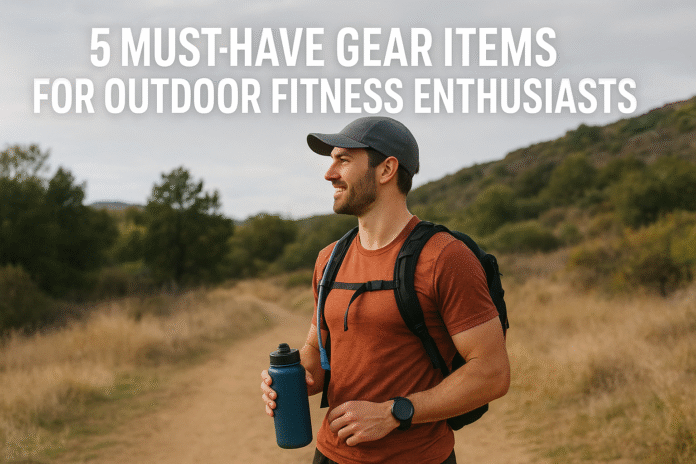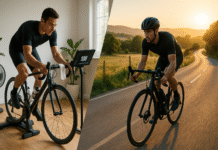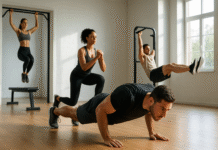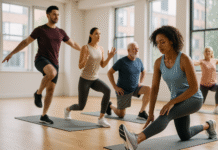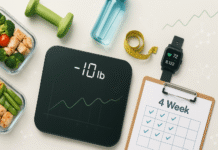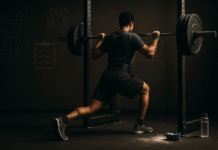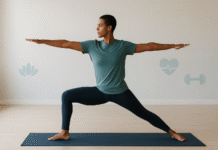Whether you’re biking singletrack at sunrise, trail-running after work, or doing a bodyweight circuit in a local park, the right gear does more than make the experience comfortable — it makes it safer, more efficient, and more enjoyable. This guide tells outdoor fitness enthusiasts exactly what five pieces of gear are non-negotiable, how to choose them, how to use them from day one, and how to scale up safely. The primary topic — outdoor fitness gear — appears early because what you carry matters to performance and long-term progress.
Medical disclaimer: This article offers general fitness, safety, and gear guidance. It is not medical advice. If you have a medical condition or are unsure whether an activity or equipment choice is safe for you, consult a qualified healthcare professional before starting.
Key takeaways
- Choose footwear first: appropriate shoes reduce injury risk and improve performance across running, hiking, and walking.
- Stay hydrated and sun-safe: carrying a hydration system and sun-protection items prevents common outdoor setbacks.
- A good daypack + emergency kit pays off: a compact kit dramatically lowers risk on longer outings.
- Wearable trackers help focus progress: accurate tracking improves consistency and motivates gradual progress.
- Start simple and scale: use beginner-friendly implementations, then progress with structured frequency and measurable KPIs.
Why gear matters (short primer)
Outdoor workouts expose you to uneven terrain, changing weather, sun, and longer durations away from immediate help. The right combination of footwear, hydration, protective apparel, a carrying system, and a tracking device reduces avoidable injuries, keeps energy stable, improves recovery, and helps you measure progress. For anyone training outdoors regularly, investing in these five items repays itself through consistency and fewer interruptions.
1) Proper footwear (trail, running, or multisport shoes)
What it is and core benefits
Footwear designed for outdoor fitness — whether trail-running shoes, hiking shoes, or multisport trainers — provides traction, protection, and shock absorption for uneven ground. Proper shoes improve gait mechanics, decrease impact forces, and reduce common overuse injuries.
Requirements / prerequisites and low-cost alternatives
- Requirements: Know your primary activity (trail running, road running, hiking, or mixed-use). Footwear should match terrain and distance.
- Low-cost alternatives: If budget is tight, start with a neutral, well-fitting athletic shoe that provides ample cushioning and a stable sole. Consider rotating two inexpensive pairs to extend lifespan.
- Costs: Entry-level specialized shoes are available at modest price points; higher-end, specialty shoes cost more. Prioritize fit over flashy features.
Step-by-step beginner implementation
- Determine activity: Decide whether you’ll mostly run on trails, walk/hike, or mix activities.
- Measure your feet: Measure length and width later in the day (feet swell). Try sizes that match your measured length with ~½–1 cm extra toe room.
- Try with socks: Use the socks you’ll actually exercise in when trying shoes.
- Test on varied surfaces: Walk, jog, and step on inclines in-store or on a short test run outside.
- Check sole and support: Ensure the sole is appropriate for traction needs and the midsole cushioning matches your preference.
Beginner modifications and progressions
- Simplify (beginner): Start with a cushioned, stable shoe for walking and short runs (20–30 minutes).
- Progress: Transition after 2–6 weeks to more activity-specific models (e.g., lighter trail shoe for faster running) as mileage and confidence grow.
Recommended frequency / duration / metrics
- Replace shoes every 300–500 miles (approx. 480–800 km) or sooner if midsole compression and outsole wear are visible.
- Track mileage per pair using a shoe log or tracker.
- For a beginner, aim for 2–4 outdoor sessions per week using the same shoe set to build adaptation.
Safety, caveats, and common mistakes
- Common mistake: Choosing shoes solely for looks or lower price without fit testing.
- Caveat: New shoes need a break-in period; introduce them gradually to avoid blisters.
- Safety tip: If you feel persistent pain (especially knee, shin, or plantar area) after a few runs, reassess fit and shoe type.
Sample mini-plan (2–3 steps)
- Buy a neutral, cushioned shoe after testing with exercise socks.
- Walk 20 minutes in them for 3 sessions over one week.
- Add one easy 20–30 minute jog in week two; monitor comfort and rotate if needed.
2) Hydration system (water bottle + hydration pack options)
What it is and core benefits
A hydration system keeps fluids accessible during workouts. Options range from handheld bottles to waist belts to hydration packs with a reservoir and drinking tube. Staying hydrated preserves performance, cognitive function, and cardiovascular safety during outdoor exercise.
Requirements / prerequisites and low-cost alternatives
- Requirements: Choose capacity based on session length and climate. Short, cool-weather sessions may require a 500–750 ml bottle. Longer sessions or hot conditions demand 1–2 liters or more.
- Low-cost alternatives: Use a reusable 500–750 ml bottle with a clip for short sessions; a simple insulated bottle helps keep water cool.
- Costs: Basic bottles are inexpensive; hydration packs cost more but add storage and hands-free sipping.
Step-by-step beginner implementation
- Estimate needs: For sessions under 60 minutes in mild weather, a 500–750 ml bottle is usually enough. For multi-hour outings or hot days, choose a 1–2 L solution.
- Plan pre-hydration: Drink ~250–500 ml (8–16 fl oz) 30–60 minutes before exercise.
- Sip regularly: Instead of waiting until thirsty, take small sips every 10–20 minutes.
- Electrolytes: For workouts longer than 90 minutes or in extreme heat, consider an electrolyte drink.
Beginner modifications and progressions
- Simplify: Start with a handheld bottle on short outings.
- Progress: Upgrade to a waist pack or hydration vest as distance and gear needs grow.
Recommended frequency / duration / metrics
- Monitor body weight before and after long sessions to estimate sweat loss.
- Aim to limit body mass loss during exercise to less than ~2% to avoid performance decrements (use pre/post weights).
- Hydration frequency: small sips every 10–20 minutes during activity.
Safety, caveats, and common mistakes
- Common mistake: Overdrinking plain water during very long events without electrolytes, which can dilute sodium.
- Caveat: Don’t rely only on thirst for long or intense sessions; thirst lags behind actual fluid needs.
- Safety tip: Practice drinking from your chosen system during training to avoid discomfort and choking while moving.
Sample mini-plan (2–3 steps)
- Bring a 750 ml bottle for a 45–60 minute outdoor session; pre-hydrate 250 ml.
- Sip 50–100 ml every 15 minutes.
- On the next similar session, swap to a 1 L bottle to build habit for longer workouts.
3) Weather-appropriate apparel and sun protection kit
What it is and core benefits
Technical clothing regulates body temperature, wicks sweat, and provides protection from wind and rain. A sun-protection kit includes a broad-brim hat, high-SPF sunscreen, and UV-blocking sunglasses. Combined, these reduce sun damage, help thermoregulation, and keep you exercising comfortably for longer.
Requirements / prerequisites and low-cost alternatives
- Requirements: Choose breathable fabrics for hot weather; insulated layers for cold weather; a lightweight shell for rain and wind.
- Low-cost alternatives: Cotton is inexpensive but holds moisture and can chafe; opt for budget synthetic blends when possible. A simple cap and sunglasses are low-cost and high-impact for sun protection.
- Costs: Performance apparel ranges widely; prioritize one good outer layer and a hat/sunglasses.
Step-by-step beginner implementation
- Check forecast: Dress in layers if uncertain; first layer should wick sweat.
- Sun prep: Apply at least SPF 30 to exposed areas 15–20 minutes before going out. Reapply every two hours or after sweating heavily.
- Sunglasses: Choose wraparound styles that block UVA/UVB.
- Hat: Use a wide-brim or cap with neck protection for longer exposures.
Beginner modifications and progressions
- Simplify: Start with moisture-wicking T-shirt, shorts, hat, and sunglasses.
- Progress: Add UV-protective long sleeves, gaiters, and a lightweight shell for extended runs or variable weather.
Recommended frequency / duration / metrics
- Reapply sunscreen every 2 hours outdoors or after swimming/sweating.
- Monitor comfort: if you’re wet and cold for more than 10–15 minutes, add a layer or cut the session short.
Safety, caveats, and common mistakes
- Common mistake: Skipping sunscreen on cloudy days. UV exposure still occurs.
- Caveat: Dark clothing absorbs more heat; choose light colors in hot conditions.
- Safety tip: In hot weather, schedule workouts for early morning or late afternoon to reduce UV intensity and heat stress.
Sample mini-plan (2–3 steps)
- For a 60-minute midday outing, wear moisture-wicking top, hat, sunglasses, and apply SPF 30+ sunscreen 20 minutes before starting.
- Carry a lightweight wind/rain shell if the forecast is uncertain.
4) Daypack with emergency and first-aid essentials
What it is and core benefits
A compact daypack or waist pack stores essentials — water, snacks, layers, and an emergency kit (basic first-aid, whistle, headlamp, and navigation). It keeps hands free and supplies accessible, reducing risk on remote or longer outings.
Requirements / prerequisites and low-cost alternatives
- Requirements: Choose capacity based on outing length: small waist packs for short runs, 10–20 L daypacks for day hikes. Include an emergency kit tailored to your route.
- Low-cost alternatives: For short sessions, a simple belt pouch plus a lightweight emergency blanket and whistle suffices.
- Costs: Basic daypacks are affordable; technical hydration packs with reservoirs cost more.
Step-by-step beginner implementation
- Select pack size: Decide if you need storage for a jacket, extra water, or food.
- Assemble essentials: At minimum, pack a bandage kit, blister supplies, safety whistle, multi-tool, headlamp/compact flashlight, and a space blanket.
- Practice access: Practice opening and closing pockets while standing so you can get items without stopping for long.
- Fit check: Adjust straps and hip belt so the weight sits on your hips for comfort.
Beginner modifications and progressions
- Simplify: For short runs, carry a small pouch with a bandage, blister tape, and phone.
- Progress: For full-day outings, add navigation tools (map/compass), additional food, and a more complete first-aid kit.
Recommended frequency / duration / metrics
- For outings under 90 minutes close to help, minimal kit is fine. For solo trips or remote days longer than 2 hours, carry a full daypack and emergency items.
- Inspect your kit monthly and after each trip to replenish consumables.
Safety, caveats, and common mistakes
- Common mistake: Overpacking heavy items for short outings; this discourages use.
- Caveat: Don’t pack items you haven’t practiced using (e.g., unfamiliar navigation gear).
- Safety tip: Share your route and expected return time with a friend when heading into remote areas.
Sample mini-plan (2–3 steps)
- Pack a 10 L daypack with 1 L water, two energy snacks, a small first-aid kit, a whistle, and a headlamp.
- Tune the pack so it rides snugly on your hips and test its comfort on a 45-minute hike.
5) Wearable activity tracker or GPS watch
What it is and core benefits
A wearable tracker or GPS watch records metrics like distance, pace, heart rate, elevation, and route. That data helps structure training, track progression, and ensure sessions align with goals.
Requirements / prerequisites and low-cost alternatives
- Requirements: Choose a device that measures the metrics you care about (GPS for distance and route, optical HR sensor for heart rate).
- Low-cost alternatives: Use a smartphone app that records GPS and pairs with a basic chest strap or wrist monitor.
- Costs: Devices range from budget trackers to advanced multisport GPS watches.
Step-by-step beginner implementation
- Decide key metrics: Is distance, heart rate, or route mapping most important? Choose a device accordingly.
- Pair and test: Pair the wearable with your phone or app and test it on a short walk to confirm accuracy and comfort.
- Set simple targets: For early consistency, set a session frequency and either a time or distance target per session.
Beginner modifications and progressions
- Simplify: Track only time and perceived exertion for the first two weeks if device setup feels overwhelming.
- Progress: Introduce heart-rate zones, interval workouts, and weekly mileage targets after baseline fitness improves.
Recommended frequency / duration / metrics
- Use the tracker every outdoor session for consistent data.
- Key KPIs: weekly active minutes, total weekly distance, and session average heart rate.
- For beginners, aim to build to 150 minutes of moderate activity across the week.
Safety, caveats, and common mistakes
- Common mistake: Treating every data point as a directive rather than context; occasional device error is normal.
- Caveat: Many consumer-grade devices estimate calories imprecisely; use trends rather than single readings.
- Safety tip: Configure emergency contacts or live-tracking features when going solo into remote areas.
Sample mini-plan (2–3 steps)
- Choose a simple GPS or app and track three outdoor sessions this week.
- Compare weekly totals to set a modest 10% increase goal for the next week.
Quick-start checklist and warm-up (practical)
Quick-start checklist (grab-and-go):
- Properly fitted shoes
- Hydration bottle or pack (filled)
- Hat, sunglasses, sunscreen (SPF 30+)
- Small daypack or belt with: phone, ID, small first-aid, snack
- Wearable tracker or phone app ready
- Weather-appropriate outer layer
5-minute warm-up (before any session):
- 60 seconds of brisk walking or light jog.
- 30 seconds of leg swings (each leg).
- 30 seconds of arm circles and shoulder rolls.
- 60 seconds of dynamic lunges (alternating).
- 60 seconds of easy strides or quick steps to elevate heart rate.
Troubleshooting & common pitfalls
- Blisters and hotspots: Break in new shoes gradually. Use lubricants or blister tape on known hotspots.
- Chafing: Wear moisture-wicking fabrics and consider anti-chafe balms for high-friction areas.
- Dehydration: If you feel dizzy or excessively fatigued, stop, rehydrate, and rest. Learn to pre-hydrate before long sessions.
- Tech frustration: If a device misrecords, reset and re-test. Log perceived exertion alongside tech metrics.
- Overpacking vs underpacking: Balance essentials with weight. Prioritize safety items for remote trips and minimize extras for sprint sessions.
Measuring progress and results
- Consistent metrics: Track session duration, distance, perceived exertion, and weekly frequency.
- Performance KPIs: Look for increases in time spent active per week, steady increases in distance (no more than ~10% weekly), and decreased perceived exertion at the same workload.
- Health markers: Use resting heart rate trends, sleep quality, and subjective recovery as additional progress indicators.
- Record-keeping: Use a simple training log (digital or paper) to chart weekly totals and notes on how you felt.
Simple 4-week starter plan (for outdoor fitness using the five gear items)
Goal: Build consistency and familiarity with gear; total weekly activity moves toward recommended moderate activity.
Week 1 — Foundation
- Sessions: 3 outdoor sessions (30 minutes each).
- Gear focus: Fit shoes and carry a 500–750 ml bottle; apply sunscreen each session.
- Intensity: Comfortable talk pace.
- Notes: Test wearable accuracy and pack comfort.
Week 2 — Habit building
- Sessions: 3–4 sessions (35–40 minutes).
- Gear focus: Try a short run/hike with a small daypack; practice sips every 15 minutes.
- Intensity: Add 2 short brisk intervals per session (30–60 seconds).
- Notes: Log distance and perceived effort.
Week 3 — Slight load increase
- Sessions: 4 sessions (40–50 minutes).
- Gear focus: Use hydration pack for one session; test emergency kit access.
- Intensity: One session with 4–6 faster intervals (1 minute on, 2 minutes easy).
- Notes: Monitor recovery and any pain.
Week 4 — Consolidation
- Sessions: 4–5 sessions (45–60 minutes).
- Gear focus: Finalize preferred shoe and pack combo; ensure sunscreen routine is habitual.
- Intensity: Include one longer session (60 minutes) or back-to-back moderate sessions (30 + 30 mins).
- Notes: Compare week totals; set target for next 4 weeks (e.g., add 10% more time or an extra session).
Safety, emergency prep, and route planning
- Route familiarity: Start on well-marked, familiar routes until you’re comfortable navigating.
- Tell someone: Share your route and expected return time, especially for solo outings.
- Carry communication: Have a charged phone and consider a small power bank for long trips.
- Know exit points: For trail loops, know the closest road access in case you need to shorten the outing.
- Basic first-aid: Learn to manage sprains, blisters, and minor cuts; carry a compress, bandages, and blister tape.
Frequently Asked Questions (8–12)
- Do I need all five items to start outdoor fitness?
No. Start with proper shoes, water, and sun protection. Add a pack, first-aid items, and a tracker as you progress. - How much water should I bring for a one-hour outdoor workout?
For a typical one-hour session in moderate conditions, 500–750 ml is usually sufficient. Increase this in heat or high exertion. - How often should I replace my running or hiking shoes?
Replace shoes every 300–500 miles or if you notice thinning cushioning or uneven wear. - Is a GPS watch necessary, or will a phone app do?
A phone app can do the basics. A GPS watch is more convenient, hands-free, and often more accurate for pace and elevation. - What SPF should my sunscreen be for outdoor workouts?
Use at least SPF 30, and reapply every two hours or after heavy sweating or water exposure. - Can I use one pair of shoes for both trail running and hiking?
Yes, many multisport shoes work across activities. For technical trails or long hikes, a sturdier hiking shoe may be preferable. - How do I avoid chafing on longer sessions?
Wear moisture-wicking clothing, use anti-chafe balms, and consider seamless or snug-fitting gear for vulnerable areas. - What should be in a basic first-aid kit for outdoor fitness?
Adhesive bandages, blister dressings, antiseptic wipes, a small compress, tape, and safety pins; add specific meds as needed. - How can I carry electrolytes without overcomplicating my pack?
Use single-serve electrolyte tablets or powder packets that dissolve in your bottle as needed. - Are wearables accurate for calorie tracking?
Consumer wearables vary; they reliably track steps and route but may estimate calorie burn imprecisely. Use trends rather than single readings. - How do I choose between a waist pack and a hydration vest?
For runs under 60–90 minutes, a waist pack or hand bottle is usually sufficient. For longer outings or when you need hands-free hydration and more storage, a hydration vest is better. - How do I train safely in extreme heat or cold?
In heat, schedule sessions for cooler parts of the day, reduce intensity, and emphasize hydration and shade. In cold, layer clothing and avoid cotton; protect extremities.
Final thoughts + motivating close
Outdoor fitness rewards consistency, curiosity, and smart preparation. Start with the five essentials here, learn how each item supports your sessions, and iterate with small upgrades as your goals expand. Respect the elements, keep safety first, and celebrate the small gains.
Ready to get outside? Lace up, pack smart, and go move — your next outdoor session is waiting.
References
- Physical activity — World Health Organization. Published: (latest web page update). https://www.who.int/news-room/fact-sheets/detail/physical-activity
- The health benefits of the great outdoors: A systematic review and meta-analysis of “green exercise” — International Journal of Environmental Research and Public Health. Published: 2019. https://www.ncbi.nlm.nih.gov/pmc/articles/PMC6562165/
- Water: How much should you drink every day? — Mayo Clinic. Published: (web page). https://www.mayoclinic.org/healthy-lifestyle/nutrition-and-healthy-eating/in-depth/water/art-20044256
- Sun protection — American Academy of Dermatology (sun-protection guidance web page). Published: (web page). https://www.aad.org/public/everyday-care/sun-protection
- The right shoe for walking and running — Harvard Health Publishing. Published: (web page). https://www.health.harvard.edu/staying-healthy/the-right-shoe-for-walking-and-running
- Daypacks: How to Choose — REI Expert Advice (how-to guide for daypack selection and fit). Published: (web page). https://www.rei.com/learn/expert-advice/daypack.html
- Hydration Packs: How to Choose — REI Expert Advice (hydration systems overview). Published: (web page). https://www.rei.com/learn/expert-advice/hydration-system.html
- Accuracy and acceptability of wrist-wearable activity-tracking devices — Journal of Medical Internet Research. Published: 2022. https://www.jmir.org/2022/1/e30791/
- Accuracy and precision of consumer-grade wearable activity monitors — PubMed (systematic review). Published: 2021. https://pubmed.ncbi.nlm.nih.gov/35943763/
- Physical activity guidelines (general exercise recommendations summary) — American College of Sports Medicine (guidelines FAQ page). Published: (web page). https://acsm.org/physical-activity-guidelines-faqs/




























